Periodontal Instrumentation
Periodontal Instrumentation Important Notes
1. Differences between Gracey curette and universal curette
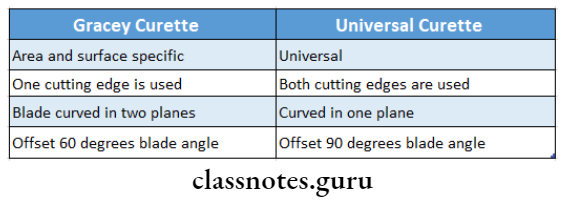
2. Gracey Curettes
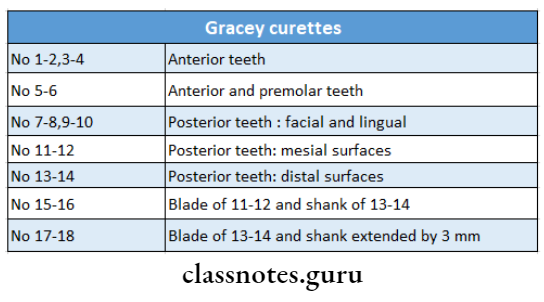
Read And Learn More: Periodontics Question and Answers
3. Extended shank curettes
- Extended Shank Curettes Example: After five curettes
- The shank is extended 3 mm than the standard Gracey which allows extension into deeper periodontal pockets
- They are available in all standard Gracey numbers except 9 and 10
4. Minibladed curettes
- Minibladed curettes Example: Mini five curettes
- Minibladed curettes are modified after five curettes with the blade length half of that of conventional curettes
- The shorter blade allows easier insertion and adaptation in deep, narrow pockets and furcation
- Minibladed curettes are available in all standard Gracey numbers except 9 and 10
5. American gracey curettes
- American Gracey curettes are four mini-bladed curettes
- The blade length is 50% shorter than that of conventional curettes
- The blade has been curved slightly upward
- American gracey curettes allows the curettes to adapt more closely to the tooth surface, especially on the anterior teeth and online angles
6. Langer and mini langer curettes
- Langer and mini langer curettes set of 3 curettes combines the shank design of the standard Gracey 5-6, 11-12, and 13-14 curettes with a universal blade angled at 90 degrees rather than the offset blade of the Gracey curettes
- Langer and mini langer curettes allows the advantage of the area-specific shank to be combined with the versatility of a universal curette blade
7. Angles in instrumentation

8. Sharpening of instruments
- During the sharpening of instruments
- The face of the blade is parallel to the floor and the stone makes a 100-110° angle with the face of the blade
- This automatically preserves an angle of 70-80° angle between the face and the lateral surface
9. The sharpness of instruments can be tested by
- Keeping the cutting edge under light, a dull instrument would reflect light while a sharp instrument does not
- The instrument is lightly drawn across an acrylic rod called a test stick. A dull instrument will slide smoothly but a sharp one would raise a light-shaving
10. Angulation
- It refers to the angle between the face of the bladed instrument and the tooth surface
- Correct angulation is essential for effective calculus removal
- For subgingival insertion of a bladed instrument such as a curette, the angulation should be close to 0°
- During scaling strokes on heavy calculus angulation should be just less than 90° so that the cutting edge bites into the calculus
- An angulation of less than 45° and greater than 90° will cause the instrument to slide over calculus and causes burnishing of calculus
11. Mounted rotary stones are not recommended because
- They are difficult to control precisely and can ruin the shape of the instrument
- They tend to wear down the instrument quickly
- Generates frictional heat which may affect the temper of the instrument
12. Hoes
- They are used for removing ledges or rings of calculus
- It makes two-point contact with the tooth and this stabilizes the instrument and prevents nicking of the root
- The blade is bent at 99° and the cutting edge is beveled at 45°
13. Ultrasonic and sonic instruments
- Used for scaling, curettage, and removing the stain
- They produce vibrations at the tip of the instrument which when adapted to the tooth causes dislodgement of calculus
- Vibrations range from 20,000 to 45,000 hertz
- The spray which is directed at the tip of the instrument dissipates heat and forms tiny vacuum bubbles that collapse quickly and release energy by a process called cavitation
- They contain a water knob that controls the volume of water being delivered to the insert tip
- Water contributes to 3 physiologic effects that enhance the efficacy of power scalers

The combination of these 3 effects disrupts microflora
Types of Ultrasonic Instruments:
- Magnetostrictive
- The pattern of vibration is elliptical
- Piezoelectric
- The pattern of vibration of the tip is linear
Contraindications:
- Patients with communicable diseases that can be transmitted by aerosols
- Patients at risk of respiratory diseases
- Patients who are immunocompromised or suffering from chronic pulmonary diseases
- Patients having porcelain or bonded restorations because they can be fractured or removed
14. Modified pen grasp
- Modified pen grasp is the most effective and stable grasp for all periodontal instruments
- Modified pen grasp creates a tripod effect with the thumb, index finger, and the pad of the middle finger
- Modified pen grasp ensures the greatest control over the instrument and also enhances maneuverability and tactile sensitivity
15. Palm and thumb grasp
- Palm and thumb grasp is unsuitable for precise and controlled movements
- Palm and thumb grasp inhibits maneuverability and tactile sensitivity
- Palm and thumb grasp is used for stabilizing instruments during sharpening and for manipulating air and water syringes
16. Rests and fulcrum
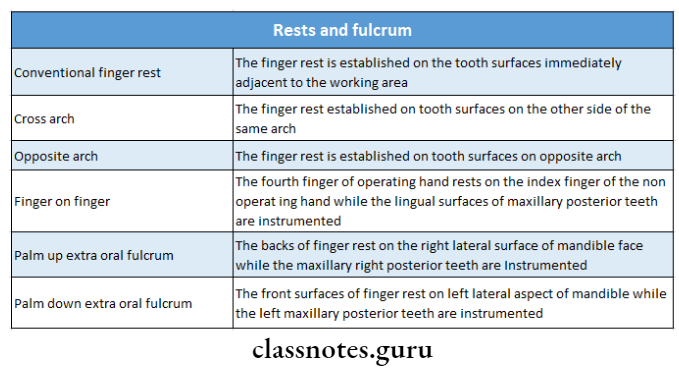
17. Chisel scaler
- It is used in the anterior part of the mouth for the proximal surfaces of teeth that are too closely spaced to permit the use of other scalers
- The instrument is activated with a push motion while other scalers are activated with pull motion
18. Adaptation
- It refers to the manner in which the working end of a periodontal blade is placed against the surfaces of a tooth
- The objective of adaptation is to make the working end of the instrument conform to the contour of the tooth surface
- Precise adaptation minimizes trauma to the soft tissues and root surfaces and ensures maximum effectiveness of instrumentation
19. Kirkland knives
- Commonly used for gingivectomy
- Used on the facial and lingual surfaces of incisors and those distal to the terminal tooth in the arch
20. Basic characteristics of scaler and curette

21. Florida probe
- It is an automated probe system
- Consists of a probe handpiece, digital readout, foot switch, computer interface and computer
- The end of the probe tip is 0.4 mm in diameter
- The probing method combines the advantages of constant probing force with precise electronic measurement and computer storage of data
- It eliminates the potential errors associated with visual reading and the need for an assistant to record the measurements
Florida probe Disadvantages:
- Lack of tactile sensitivity
- Patient discomfort
- Inaccurate measurements
- Underestimation of deep probing depths by the automated probe
22. Scaling stroke
- It is a short, powerful pull stroke that is used with a bladed instrument for the removal of both supragingival and subgingival calculus
- The muscles of the fingers and hands are tensed to establish a secure grasp and lateral pressure is firmly applied against the tooth surface
23. Uses of explorer
- To locate sublingual deposits and various areas
- To check the smoothness of root surfaces after root planning
Periodontal Instrumentation Long Essays
Question 1. Classify periodontal instruments. Describe anyone in detail.
Answer:
Periodontal Instruments Classification: According to purpose, instruments are classified as
- Periodontal probe
- Explorer
- Scaling, root planning, and curettage instruments
- Sickle scalers
- Currencies
- Hoe, chisel, file scalers
- Ultrasonic and sonic instruments
- Periodontal endoscope
- Cleansing and polishing instruments
- Rubber cups
- Brushes
- Dental tapes

Periodontal Instrumentation Short Essays
Question1. Universal Curettes.
Answer:
As can be used for most areas of the dentition
Universal Curettes Indication:
- Deep sub-gingival scaling
- Cementum alteration
- Removal of the soft tissue lining of a pocket
Universal Curettes Parts:
- Removal of the soft tissue lining of the pocket
- Face-90° to lower shank
- Adapted towards tooth surface
- Shank
- Cutting edge-Two edges
- Both can be used

- Curvature – Blades curve upward
- Blade Angle – 90°
Question 2. Gracey Curettes/Area-specific curettes.
Answer:
- Area-specific curettes
- Angle – 60° offset
- Cutting edge – Outer end only is used Curvature
- Curves upwards and sideways
- Use – Sub-gingival scaling and root planning
Gracey Curettes Types:
- 1-2 and 3-4-For interiors
- 5-6-Anteriors, premolar
- 7-8, 9-10 – Posteriors – Facial and lingual
- 11-12 – Posteriors – mesial
- 13-14 – Posteriors – distally
Gracey Curettes Recent Advances – 15-16 and 17-18
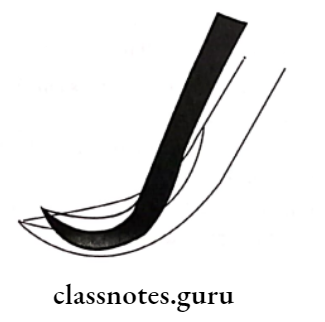
Question 3. Corvettes.
Answer:
Types-Sub-O:
- 1-2- anterior and premolars
- 11-12-posteriors medial
- 13-14-posteriors distal
Modification From Conventional Gracey Cu- Rettes:
- 50% shorter blade length
- The curvature of the blade upwards
Corvettes Importance:
- Due to curvature, there is a better adaptation to tooth surfaces
Question 4. Endoscope/Perioscope.
Answer:
Endoscope Use:
- Diagnosis and treatment of periodontal diseases
Endoscope Part:
- Fibre optic – Reusable
- Sterile sheath – Delivers water for irrigation
- Covering fiber optic
- Periodontal probe/ultrasonic instruments
Endoscope Advantages:
- Clear visualization subgingivally
- Detects the presence and location of sub-gingival deposits
- Guides the operation
- Helpful in root debridement in inaccessible areas
Periodontal Instrumentation Short Question and Answers
Question 1. Langer’s curettes.
Answer:
- Langer’s curettes is a set of 3 curettes
- These contain combined features of Gracey and univer- sal curettes
- Can be adapted both on the mesial and distal surfaces
- Consist of shank design of the standard Gracey #5-6, 11- 12, and 13-14 curette
- Has a universal blade angled at 90 degrees.
Question 2. Cleaning and Polishing instruments.
Answer:
1. Rubber cups: Rubber shell
- Used in handpiece
2. Bristle brushes: Wheel and cup-shaped
- Used in handpiece with paste
3. Dental tape: For polishing proximal surfaces
- Air powder polishing – Uses air-powdered slurry of warm water and sodium bicarbonate
Question 3. Prophyjet.
Answer:
Special handpiece
Prophy jet Use:
- Removal of extrinsic stains and soft deposits:
Prophy jet Method:
- Delivers air-powdered slurry of warm water and sodium bicarbonate
Prophy jet Disadvantages:
- Loss of tooth structure
- Transient gingival tissue damage
- Roughening of restoration
Prophy jet Contraindications:
- Systemic diseases
- Patients on medications that affect electrolytic balance
Question 4. Kirkland knife
Answer:
- Used for gingivectomy
- The entire periphery is cutting-edge
- Shape- kidney-shaped
Kirkland knife Types:
- Double-ended and single-ended
- Disposable and reusable
- Flat-bladed and interproximal
Question 5. Naber’s probe.
Answer:
- Naber’s probe is a curved blunt probe
- Color-coded markings are present at 3, 6, 9, and 12 mm It is used to detect furcation areas

Question 6. Classify periodontal instruments
Answer:
Periodontal Instruments Classification: According to purpose, instruments are classified as
- Periodontal probe
- Explorer
- Scaling, root planning, and curettage instruments
- Sickle scalers
- Currencies
- Hoe, chisel, file scalers
- Ultrasonic and sonic instruments
- Periodontal endoscope
- Cleansing and polishing instruments
- Rubber cups
- Brushes
- Dental tapes
Question 7. Sharpening stones
Answer:
- Sharpening stones is obtained from natural mineral deposits or artificially
- Sharpening stones surface is made up of abrasive crystals
Sharpening Stones Types:
1. Based on crystal size:
- Coarse stones:
- Have larger particles
- Cut more rapidly
- Used for dull instruments
- Finer stones
- Have smaller crystals
- Cut more slowly
2. Method of use:
- Mounted rotary stones:
- Mounted on a metal mandrel/handpiece
- Unmounted stones:
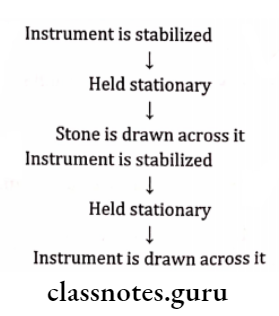
Sharpening Stones Examples: Carborundum, ruby, and ceramic stones
Question 8. Excisional and incisional instruments
Answer:
- Periodontal knives
- Interdental knives
- Ex-Orban knife
- Used for interdental areas
- They are pear-shaped knives
- Cutting edges are present on both sides of the blade
- Surgical blades
- Used for periodontal surgery
- They are beak-shaped
- Cutting edges are present on both sides
- Used with pushing and pulling cutting motion
- Commonly used- 12D, 15 and 15C
Question 9. Florida probe.
Answer:
Florida Probe is a computerized periodontal probe
Florida Probe Consists of:
- Probe handpiece
- Footswitch
- Digital readout
- Computer
- Computer interface
Florida Probe Method of Use:
- The probe tip is 0.4 mm in diameter
- Insert probe tip
- Measures are made electronically
- Transfer to the computer when the foot switch is pressed
- Constant probing provided by coil springs inside the probe handpiece and digital readout
Q.ultrasonic 10. Cavitation
Answer:
Seen with the use of ultrasonic instruments
Cavitation Production

Question 11. Contraindications of ultrasonic instruments
Answer:
- Patients with
- Cardiac pacemakers
- Communicable disease
- Respiratory disease
- Gag reflex
- Porcelain crowns
- Titanium implants
- Dentinal hypersensitivity
- Newly erupted teeth
- Young teeth with a large pulp chamber
Question 12. Mechanism of ultrasonic scalers
Answer:
Ultrasonic scalers work by converting electrical energy into mechanical energy in the form of vibrations of the working tip
Ultrasonic Scalers Frequency Used: 18000-50000 cycles/sec
Ultrasonic Scalers Types:
1. Piezoelectric
- Ceramic disc is present
- When electrical energy is applied the tip moves in a linear path creating two active surfaces
2. Magnetostrictive
- Consist of the metal stalk
- When electrical energy is applied vibration travels from the stalk to connect the body to tip
- Tip travels in an elliptical motion covering all surfaces
Question 13. Hazards of ultrasonic scalers
Answer:
- Aerosol production
- Heat production
- Damage to the restoration
- Roughening of cementum
- Enamel abrasion
- Tissue damage
Question 14. Instrument grasps
Answer:
- A proper grasp is essential for precise control of movements made during periodontal instrumentation
1. Modified pen grasp
- It is the most effective and stable grasp for all periods on- all instruments
- It creates a tripod effect with the thumb, index finger, and the pad of a middle finger
- It ensures the greatest control over the instrument and also enhances maneuverability and tactile sensitivity
2. Palm and thumb grasp
- It is unsuitable for the precise and controlled movements
- It inhibits manoeuvrability and tactile sensitivity It is used for stabilizing instruments
- during sharpening and manipulating air and water syringes
Question 15. Mini curettes
Answer:
- After five curettes have a shank 3 mm longer
- Mini-bladed curettes are modifications after five curettes
- It has a shorter blade
- This allows easier insertion and adaptation in deep pockets, furcation, developmental grooves, line angles
- Available in all standard Gracey numbers except for #9, 10
Periodontal Instrumentation Viva Voce
- In sonic units, the tip will have the orbital type of vibrating action
- Periotrievers are a set of two double-ended, highly magnetized instruments used for retrieval of broken tips from pockets and furcation
- Scaling and root planning are done to restore gingival health by completely removing elements that provoke gingival inflammation
- India and Arkansas oilstones are examples of natural abrasive stones
- Carborundum, ruby, and ceramic stones are synthetic- locally produced
- The primary goal of scaling and root planning is to restore the gingiva to health by removing the irritants which provoke the inflammation
- After scaling the gingiva which is edematous and swollen undergoes shrinkage
- The function of an explorer is to locate caries
- The sickle scalers are used to remove supragingival calculus
- Hoe is used for the removal of tenacious subgingival calculus and altered cementum
- Perioscope is used to visualize deeply into subgingival pockets and furcation
- Furcation areas are best evaluated by Naber’s probe
- UNC 15 probe has color coding at 5, 10, and 15 mm
- The smoothness of the root surfaces after root planning is checked by the explorer
- Sickle scalers are used with a pull stroke
- The cutting edge of a curette is present on both sides of a working end
- Langer and mini Langer curettes is combination of standard Gracey and universal curettes
- Schwartz periotrievers are designed for removal of broken instruments from deep pockets
- The part function of a periodontal file is to fracture or crush large deposits of calculus
